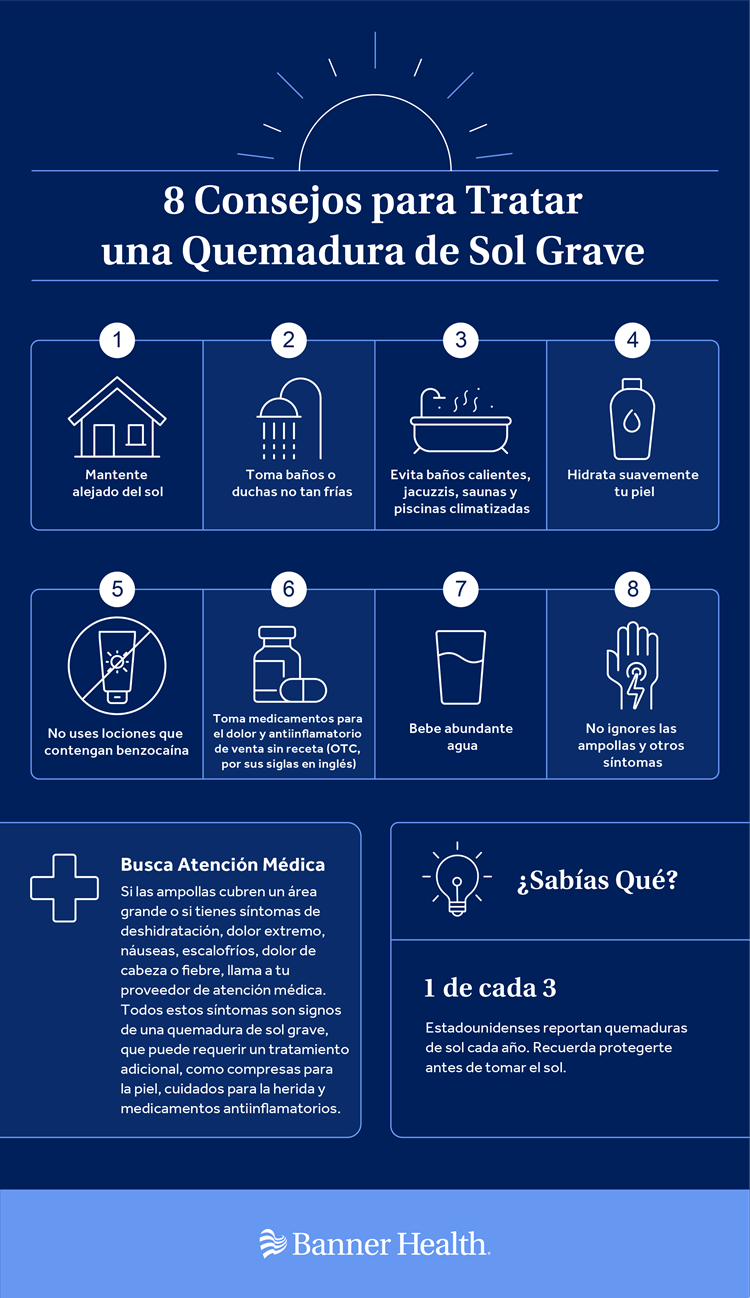!Ay, lo volviste a hacer de nuevo! Pasaste demasiado tiempo al sol y ahora estás rojo como un camarón.
En un mundo perfecto, cubriríamos la piel con protector solar antes de pasar un tiempo al sol, y volveríamos a aplicarlo con frecuencia. Pero seamos realistas: los errores ocurren. La mayoría de las personas en algún momento de sus vidas se quemarán.
Divertirse demasiado bajo el sol, e incluso en un clima parcialmente nublado, puede causar daños de muchas formas. Puede que te parescas al amigo de Ariel en la Sirenita, Sebastian, y convertirte en el blanco de las bromas de tus amigos, pero lo que es peor, puedes causar un daño duradero a tu piel, lo que te pone en mayor riesgo de cáncer de piel (en inglés).
"Las quemaduras de sol repetidas se han relacionado con el cáncer de piel, por lo que ser consciente de tu entorno y mantenerse cubierto o usar protector solar es realmente importante a corto y largo plazo,” dijo el doctor Bellal Joseph (en inglés), un cirujano de trauma y general del centro médico Banner - University Medical Center Tucson (en inglés). "La prevención de quemaduras es un paso importante (en inglés) en la prevención de cáncer de piel, porque puede ayudarte a evitar o minimizar por completo cualquier problema mientras estás bajo el sol.”
Si bien es posible que sepas lo que debes hacer para evitar una quemadura, ahora ve el error de lo que hiciste y necesitas ayuda ¡DE INMEDIATO! para el calor rojo y cálido que irradia tu cuerpo.
El doctor Joseph comparte algunos pros y contras para ayudar a aliviar tu sufrimiento y calmar el dolor.
Qué hacer y Qué No Hacer para Tratar las Quemaduras de Sol Graves
Manténte alejado del sol. Esto debería ser evidente, pero si sientes que tu piel se está quemando, busca una sombra o ve adentro de inmediato.
Toma un baño o una ducha poco fría. El agua no tan fría puede ayudar a disminuir la inflamación y aliviar el dolor. Para áreas más pequeñas, puedes usar una compresa fría (en inglés); simplemente evita aplicar hielo directamente sobre la piel.
No te bañes ni te duches con agua caliente; esto incluye jacuzzis, saunas y piscinas climatizadas. El agua caliente puede agravar tu piel inflamada y posiblemente causar más daño.
Hidrata la zona afectada. Cuando salgas de la bañera o de la ducha, dáte una palmadita suave con una toalla. Mientras tu piel aún esté húmeda, aplícate una crema hidratante. Los humectantes que contienen aloe vera son calmantes para muchas personas, pero el aloe vera no es necesario. Las quemaduras de sol resecan la piel, por lo que la hidratación es clave. También puede ayudar con cualquier opresión y picazón que puedas sentir.
No uses lociones con benzocaína. Estos pueden irritar la piel o provocar una reacción alérgica.
Toma analgésicos de venta sin receta (OTC, por sus siglas en inglés). Toma ibuprofeno o acetaminofén para ayudar a aliviar el dolor y reducir la inflamación. No tomes más de lo recomendado.
Bebe abundante agua. Mantente hidratado bebiendo mucha agua (en inglés). Esto es clave ya que las personas que pasan mucho tiempo bajo el sol pueden deshidratarse.
No ignores las ampollas o los síntomas de deshidratación. Si tienes ampollas que cubren un área grande o estás experimentando dolor extremo, náuseas, escalofríos, dolor de cabeza, fiebre o síntomas de deshidratación, llama a tu proveedor de atención médica. Todos estos son signos de una quemadura solar grave, que puede requerir un tratamiento adicional, como compresas para la piel, cuidado de heridas y medicamentos antiinflamatorios.
“El intoxicación solar puede comenzar igual que una quemadura de sol, pero se extiende a otros síntomas como sarpullido, ampollas, a veces incluso fiebre, escalofríos, náuseas y malestar general,” dijo el doctor Joseph. "Si tienes algún síntoma de deshidratación o ampollas considerables, asegúrate de que tu médico te examine.”
Para encontrar un especialista de Banner Health cerca de ti, visita bannerhealth.com.
Artículos Relacionados:
- Quemaduras: Tipos, Grados y Prevención
- Cómo Tratar una Quemadura Química (en inglés)
- Enciende la Parrilla, Pero No te Olvides de Estas Sugerencias de Seguridad
- Sugerencias de Seguridad para el Verano: Todo lo que Debes Saber para Disfrutar de la Temporada
- Lo Esencial del Botiquín de Primeros Auxilios y de Medicamentos que Debes Tener en el Gabinete (en inglés)



